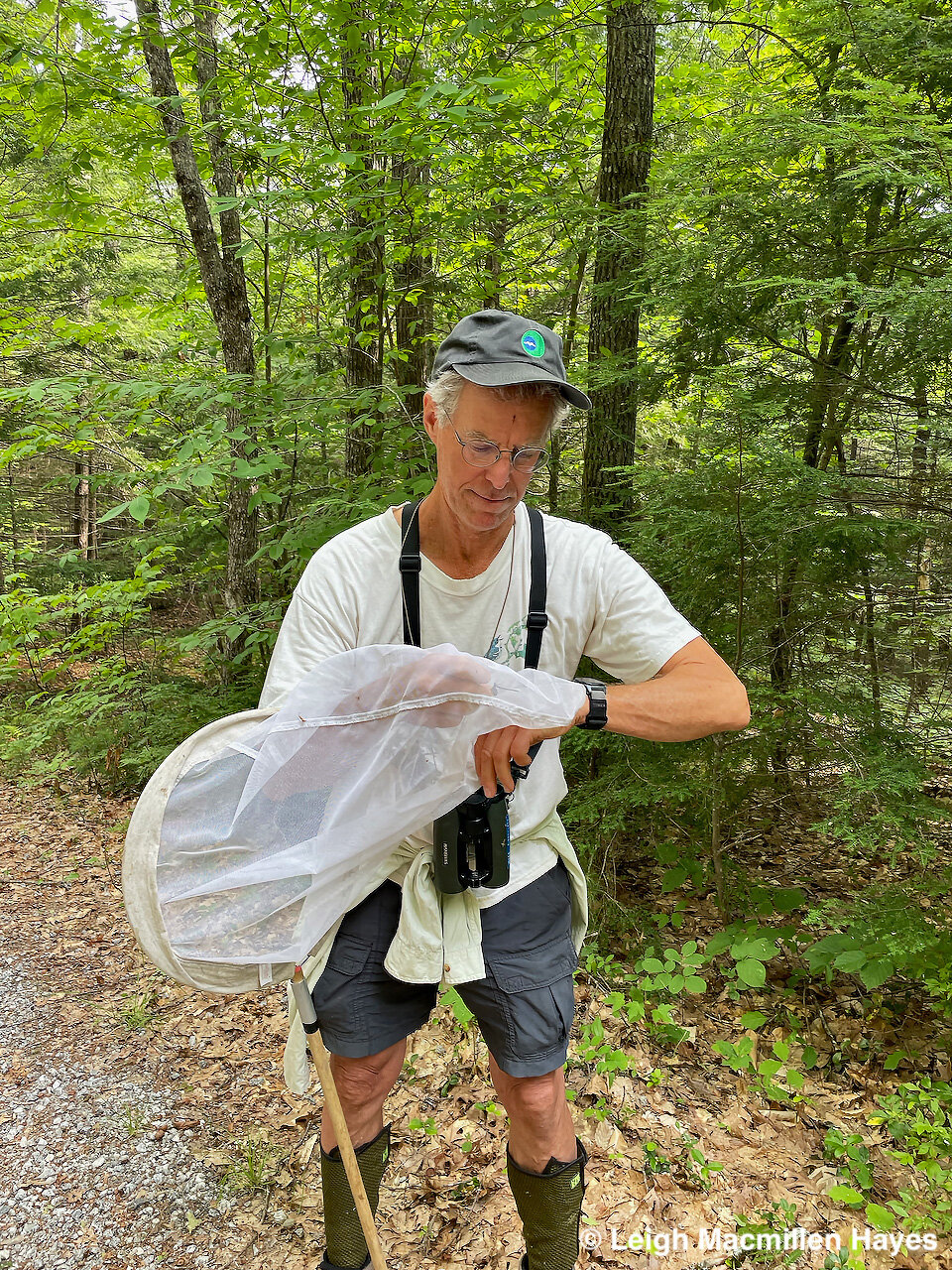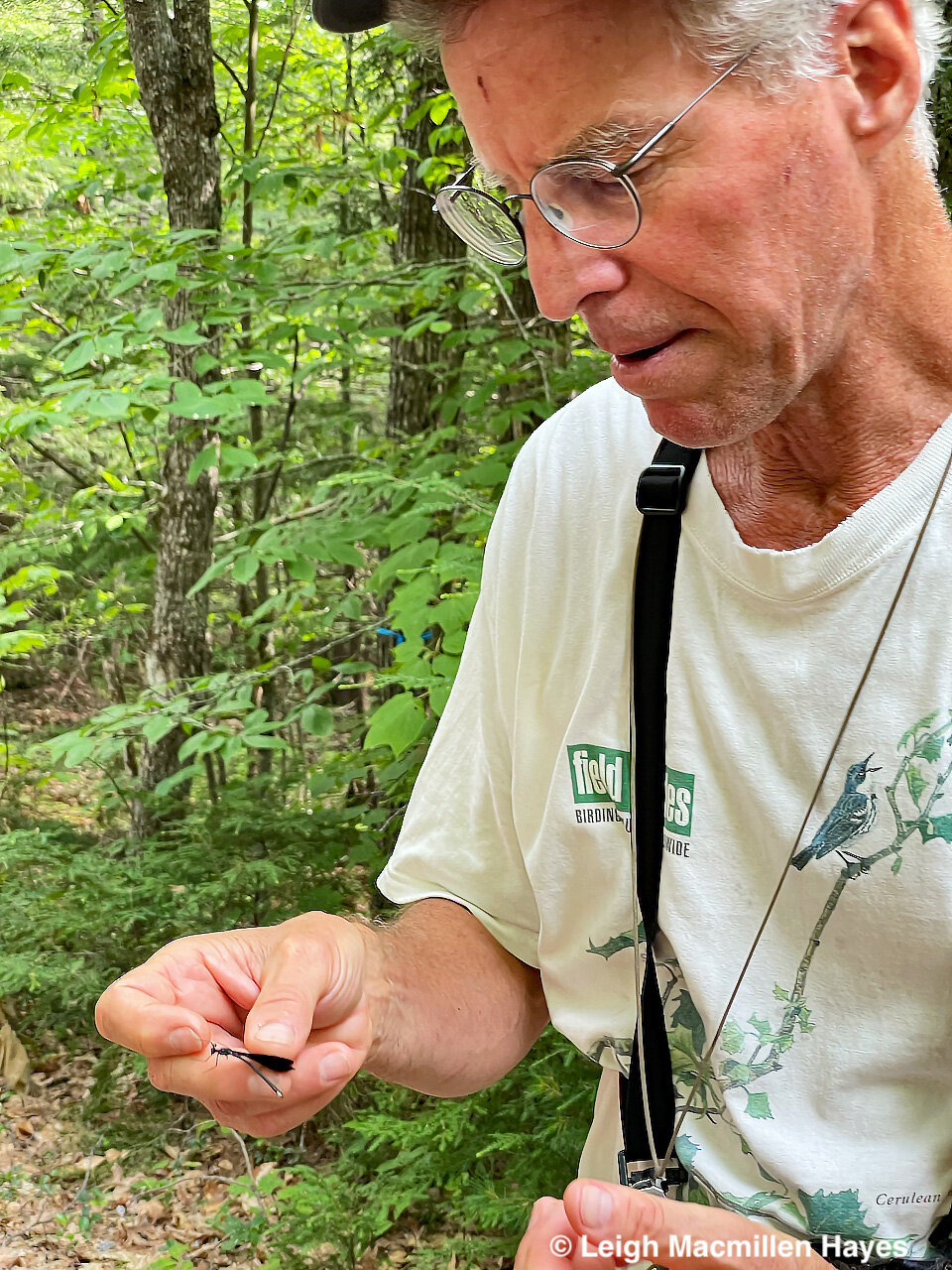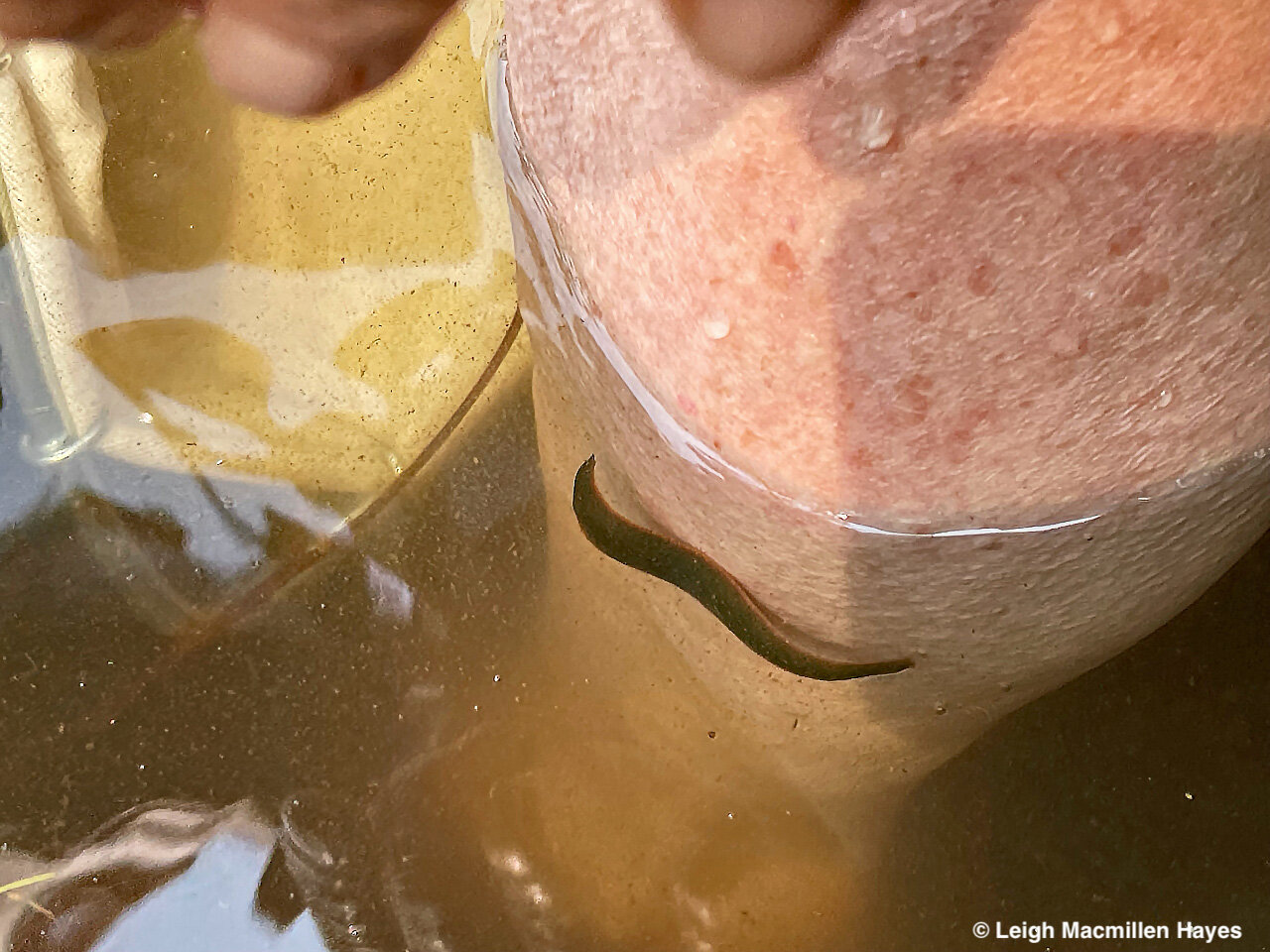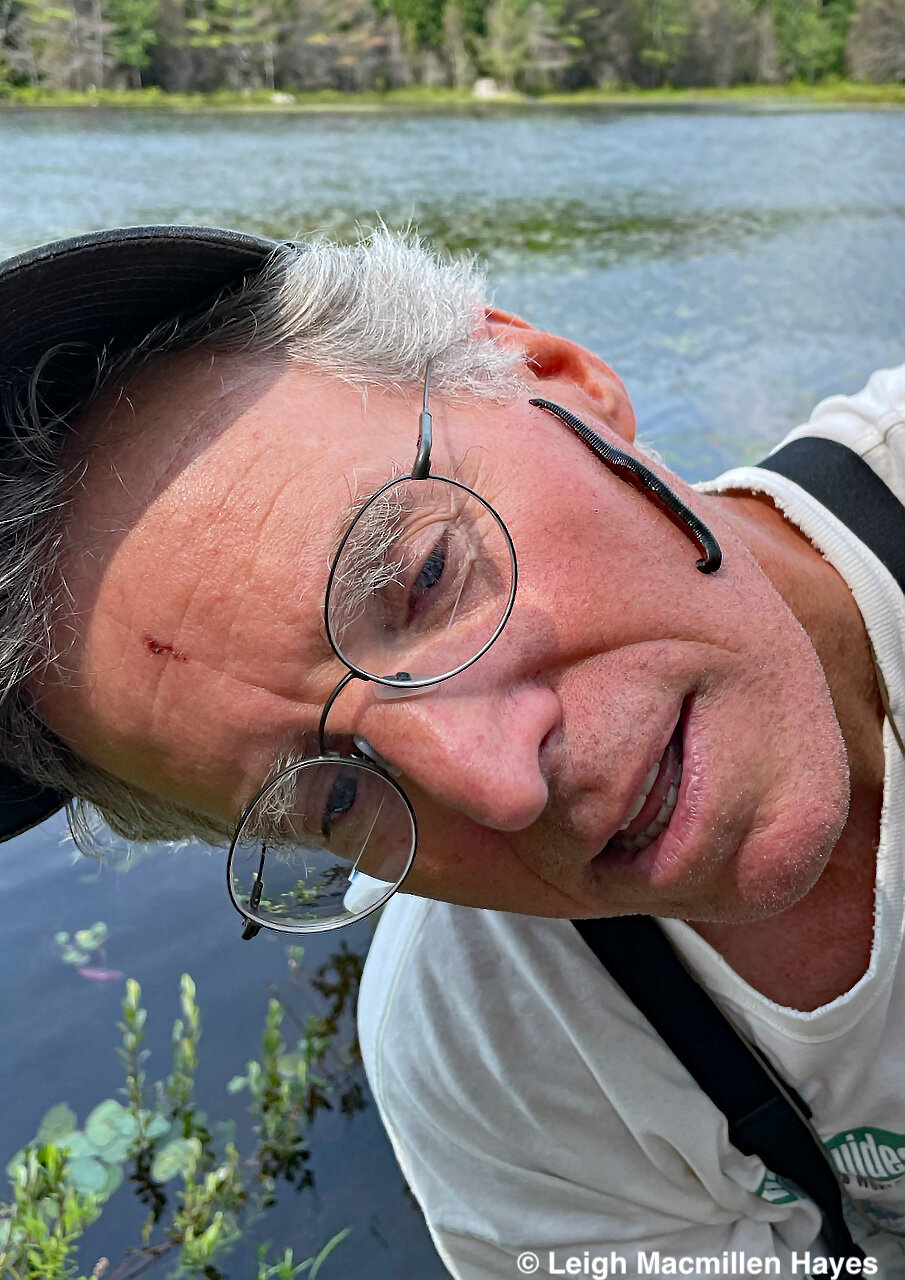Erika Rowland, executive director of Greater Lovell Land Trust, asked me a year ago to consider finding someone who could give a talk about leeches. And so the search was on. Back in February I found just the right person. At first he declined the invitation, but I enticed him with a place to stay thanks to GLLT members Linda and Heinrich Wurm (she asked that he not bring any live leeches with him) and through a couple of email exchanges we set up a date and time and accommodations. And so it was that we had the absolute pleasure of learning from Dr. Nat Wheelwright and his delightful wife Genie.
Nat is well known for the book he co-authored with Bernd Heinrich: The Naturalist’s Notebook. He’s also known for Nature Moments, including the one that cinched the deal for me: Swimming with Leeches.
Certain that not everyone would be fascinated by leeches, he suggested that he talk about other nature moments and so it began with a look at Bracken, a sometimes waist high fern with triangular fronds that provides a great place for children to hide, or when placed atop ones head, an insect distractor as they’ll go to the highest point, being the stem, and leave you alone. As Nat explained, it’s a prolific fern that mainly reproduces by rhizomes rather than spores. I can think of only a few occasions when I’ve spied the spores on the undersides of the leaflets . . . and believe me, I’ve turned many over in hopes of spying such.
We had about a mile-long walk along a woods road to our destination beside a pond, and were overjoyed that Nat showed off our favorite syndrome: Nature Distraction Disorder as any little thing captured his attention and he couldn’t wait to share it with us. Each time, we thought we knew exactly what he’d share, and then he’d add some tidbit we’d not realized or considered before.
Really, what more could one learn about an American Toad? Until we did. How to tell its gender! Grasp it by its underarms. If it makes a noise, it’s a male! Huh? Yup, because that’s where a male would clasp a female in amplexus and if he thinks another male is grasping him he needs to let it know it has made the wrong choice. We have a frog and toad safari coming up with a bunch of youngsters and this will certainly be on the agenda.
The closer we got to our destination, the more we began to spy Ebony Jewelwing damselflies. As Nat explained, living by the coast, this is a rare species for him, but in our region of western Maine, with so many lakes, ponds, rivers, brooks, and streams, we see them frequently.
What would we learn from him about this species?
Again, how to tell the gender. Male or female? What do you think?
See the second segment of the abdomen where the arrow points? That bulge under segment two is where the secondary genitalia are located. This is clearly absent in females. Therefore–this specimen was a male.
We gave him another way to identify the gender of Ebony Jewelwings: the male’s wings are solid black, while the female has a white psuedostigma toward the tip of each wing.
And notice the white at the tip of the abdomen? That’s pruinosity, which like dragonflies, occurs in mature damsels. Not a gender idiosyncrasy, but rather one of age.
It took us a wonder-filled while, but eventually we made it to the pond of our destination and several of us took off our hiking boots and splashed our feet in the water. To cool off on a hot summer day? Certainly a benefit. To attract a leech or two? Well, we tried, but there were no takers.
Interns Emily and Anna had been there the day before and suggested another spot that might lead us to the leeches we desired and so we walked back along the road and headed down another path to the water. But . . . there was another story to share first of Genie’s experience swimming with tadpoles one day and the demise of said tadpoles a couple of days later and a discovery of ranavirus, which kills frogs in a short time period. Nat did tell us that the pond where the discovery was made seemed to be recovering; maybe some frogs exhibiting a resistance to the virus.
One of the take-aways from this is to always clean your equipment, including trays and D-nets, between pond explorations so if one pond is affected you don’t accidentally spread the virus to another.
That said, we reached a shallow area of the water’s edge, and Moira, Nat, and I took off our hiking boots and socks and stepped into the water. So . . . what did it feel like? Mucky. And rooty. And did I say mucky. BUT . . . it was only a matter of minutes and a blood-sucking leech found my leg. We tried to capture it, however, it wasn’t ready to be the star of the show and quickly released itself. That’s not how it usually goes with such, and a shake of salt would have been necessary to get it to release. I should have been thankful.
Then we spied a much larger leech swimming about and I got out so others could get closer to the pond’s edge and see it. Moira stood still as it circled her leg over and over again.
At last, either she or Nat captured it and placed it in a tray for all to observe. At its longest stretch, it was about five inches, though sometimes it appeared to be only about an inch in length.
In awe, we watched it move gracefully as its body contracted and protracted around the edge of the tray. And then the moment of anticipation came. Time for an up-close-and-personal look.
By the line of spots on its back . . .
and orange belly, Nat identified it as the common and colorful Macrobdella decora—North American medicinal leech, apparently used for bloodletting, but not one that would harm us as we continued to witness.
The more time we spent with Della . . .
the more comfortable we became in its presence, and soon learned that it moves rather like a slinky and we needed to place one hand below the next to keep its rhythm going.
That said, it was rather disconcerting. I mean: leeches are to be feared. We’ve spent a lifetime honing that attitude.
But . . . after spending a little time with them, I realized I truly don’t understand their ecology, but I’ve certainly gained a new respect, including the understanding that they have a brain and a sucker at each end. There’s a whole lot more to them than meets our eyes–including the fact that they have ten . . . eyes, that is, if I’ve got my facts correct.
First, we thought standing in the water was enough of a challenge. And then holding the leech. But . . . Nat had one more challenge–let the leech crawl on your face. Have you ever? Genie was willing to give it a try, but it fell off.
Moira gladly also gave it a try, but it fell to the ground.
Nat, however, was the most successful . . . until we were all certain it was headed into his ear.
Did you know this about leeches?
some families are jawless, some toothless, and some feed through a tube
leeches swallow their prey whole, extract the bodily fluids, and spit out the crunchy-bits, rather like a carnivorous plant
they prey on invertebrates, turtles, frogs, ducks, or fish
they are eaten by crayfish, salamanders, birds, turtles, carnivorous aquatic insect larvae, and fish
There is so much more for me to comprehend, but what a great beginning. Today we were be-leeched at Greater Lovell Land Trust with many, many thanks to Nat and Genie Wheelwright for traveling to western Maine to share their nature moments with us, Linda and Heinrich Wurm for hosting the Wheelwrights overnight, and Moira Yip and Vanny Nelson for being today’s lead docents. (Vanny, a former intern, nailed the intro–Nat was impressed, as we all were. And they have a Bowdoin College allegiance.)





















